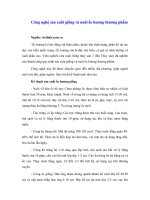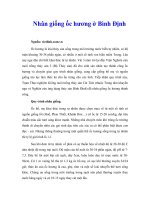方斑东风螺对蛋白质和脂肪营养需求的研究 Ốc hương Babylonia
Bạn đang xem bản rút gọn của tài liệu. Xem và tải ngay bản đầy đủ của tài liệu tại đây (462.3 KB, 17 trang )
学校编码:10384
分类号 _____ 密级_______
学号:200334032
UDC ____
_
要
库
硕士学 位 论 文
摘
方斑东风螺对蛋白质和脂肪营养需求的研究
论
Link
文
Studies on protein and lipid requirement of Babylonia areolata
士
许贻斌
硕
指导教师姓名:柯才焕教授
论文提交日期:2006 年 8 月 10 日
论文答辩时间:2006 年 9 月 2 日
学位授予日期:
年 月
日
厦
门
大
学
博
专 业 名 称:环境科学
答辩委员会主席:陈木 研究员
评
阅
人:
刘光兴 教授
刘 晓 研究员
2006 年 9 月
库
厦门大学学位论文原创性声明
兹呈交的学位论文,是本人在导师指导下独立完成的研究成
要
果。本人在论文写作中参考的其他个人或集体的研究成果,均在文
摘
中以明确方式标明。本人依法享有和承担由此论文产生的权利和责
论
文
任。
厦
门
大
学
博
硕
士
声明人(签名):
年 月 日
厦门大学学位论文著作权使用声明
库
本人完全了解厦门大学有关保留、使用学位论文的规定。厦门
要
大学有权保留并向国家主管部门或其指定机构送交论文的纸质版和
摘
电子版,有权将学位论文用于非赢利目的的少量复制并允许论文进
文
入学校图书馆被查阅,有权将学位论文的内容编入有关数据库进行
检索,有权将学位论文的标题和摘要汇编出版。保密的学位论文在
本学位论文属于
),在
博
2、不保密(√)
年解密后适用本授权书。
硕
1、保密(
士
论
解密后适用本规定。
大
学
(请在以上相应括号内打“√”)
日期:
年
月
日
导师签名:
日期:
年
月
日
厦
门
作者签名:
目
录
中文摘要..................................................................................................... I
ABSTRACT............................................................................................III
1 前 言.......................................................................................................1
库
1.1 研究目的和研究意义 ......................................................................................1
1.2 关于水产动物营养价值的研究概况 ..............................................................2
要
1.3 关于水产动物营养需求的研究概况 ..............................................................6
摘
1.4 关于水产动物蛋白质需求量的研究概况 ......................................................6
文
1.5 关于不同蛋白含量对饲养水产动物生化成分和消化酶影响的研究概况 11
1.6 关于水产动物脂肪需求量的研究概况 ........................................................13
论
2 材料与方法 ...........................................................................................16
士
2.1 东风螺的营养成分分析和营养价值评定 ....................................................16
2.2 方斑东风螺对饲料蛋白质需要量的研究 ....................................................17
硕
2.3 不同饲料蛋白水平对方斑东风螺肉质生化组成和主要消化酶的影响 ....20
博
2.4 方斑东风螺对饲料中脂肪需要量的研究 ....................................................22
2.5 数据处理和分析 ............................................................................................25
学
3 结果........................................................................................................26
大
3.1 东风螺的营养成分分析和营养价值评定 ....................................................26
门
3.2 方斑东风螺对饲料蛋白质需要量的研究 ....................................................32
厦
3.3 不同饲料蛋白水平对方斑东风螺肉质生化组成和主要消化酶的影响 ....35
3.4 方斑东风螺对饲料中脂肪需要量的研究 ....................................................38
4讨
论....................................................................................................41
4.1 东风螺的营养成分分析和营养价值评定 ....................................................41
4.2 方斑东风螺对饲料蛋白质需要量的研究 ....................................................44
4.3 不同饲料蛋白水平对方斑东风螺肉质生化组成和主要消化酶的影响 ....46
4.4 方斑东风螺对饲料中脂肪需要量的研究 ....................................................48
5 创新点....................................................................................................50
6 不足之处................................................................................................50
7 研究展望................................................................................................50
参考文献...................................................................................................52
致
谢......................................................................................................60
厦
门
大
学
博
硕
士
论
文
摘
要
库
附 录..........................................................................................................61
Contents
Chinese abstract ·······················································································Ⅰ
English abstract························································································Ⅲ
1 Introduction·····························································································1
库
1.1 Main purpose of present study ···································································· 1
1.2 Survey in the studies on aquatic animal nutritional value························ 2
要
1.3 Survey in the studies on nutrients requirement of aquatic animal ·········· 6
1.4 Survey in the studies on dietary protein requirement of aquatic animal 6
摘
1.5 Survey in the studies on effects of different protein level on nutritional
文
composition and the main digestive enzymes activities of feeding aquatic
animals ··········································································································· 11
论
1.6 Survey in the studies on dietary lipid requirement of aquatic animal ·· 13
2 Materials and methods·········································································16
士
2.1 Analysis and evaluation of nutritional composition of Babylonia areolata
硕
Link and Babylonia formosae habei Altena&Gittenberger······················· 16
2.2 Studies on protein requirement of Babylonia areolata Link ··················· 17
博
2.3 Effects of different protein level on nutritional composition and the main
学
digestive enzymes activities of Babylonia areolata Link ···························· 20
2.4 Studies on lipid requirement of Babylonia areolata Link························ 22
大
2.5 Data treatment and statistic analysis ························································ 25
3 Results ····································································································26
门
3.1 Analysis and evaluation of nutritional composition of Babylonia areolata
厦
Link and Babylonia formosae habei Altena&Gittenberger······················· 26
3.2 Studies on protein requirement of Babylonia areolata Link ··················· 32
3.3 Effects of different protein level on nutritional composition and the main
digestive enzymes activities of Babylonia areolata Link ···························· 35
3.4 Studies on lipid requirement of Babylonia areolata Link························ 38
4 Discussion·······························································································41
4.1 Analysis and evaluation of nutritional composition of Babylonia areolata
Link and Babylonia formosae habei Altena&Gittenberger······················· 41
4.2 Studies on protein requirement of Babylonia areolata Link ··················· 44
4.3 Effects of different protein level on nutritional composition and the main
digestive enzymes activities of Babylonia areolata Link ···························· 46
4.4. Studies on lipid requirement of Babylonia areolata Link······················· 49
5 Innovation ······························································································50
6 Insufficiency of this study ···································································50
7 Research expectation ············································································50
库
References ·································································································52
要
Acknowledges ···························································································60
厦
门
大
学
博
硕
士
论
文
摘
Appendix ···································································································61
库
要
摘
文
论
士
硕
博
学
大
门
厦
摘 要
摘
要
方斑东风螺(Babylonia areolata Link)是我国东南沿海主要的腹足类经济动
物之一。本文首先对方斑东风螺和波部东风螺(Babylonia formosae habei Altena
& Gittenberger)自身营养成分进行分析,测定其中的含肉率和腹足肌含有的基本
库
营养成分,分析氨基酸种类及组成和脂肪酸种类及组成,对方斑东风螺和波部
要
东风螺的营养价值进行综合评定以及对比分析;然后以白鱼粉和酪蛋白为蛋白
源设计了 8 个不同蛋白质水平的饲料,在水温 26.90±1.52 ℃、盐度 27.6±0.5 及
摘
遮光的条件下对初始个体体重为 2.16±0.05g 的方斑东风螺进行为期 60d 的饲养
文
实验,以确定方斑东风螺对饲料中蛋白质需要量,并对方斑东风螺饲养不同蛋
论
白水平饲料 60d 后的肉质生化组成和主要消化酶进行实验分析。最后在确定方
斑东风螺对饲料中蛋白质需要量的基础上,以白鱼粉和酪蛋白为蛋白源,鱼油
士
为脂肪源设计了蛋白质含量 43%的 5 个不同脂肪水平(4%,7%,10%,13
硕
%,16%)的饲料,在水温 28-30℃、盐度在 25-28 及遮光的条件下对初始个
体体重约为 1.95g 的方斑东风螺进行为期 60 d 的饲养实验确定方斑东风螺对饲
博
料中脂肪需要量。结果如下:
学
1. 方斑东风螺和波部东风螺的营养成分分析和营养价值评定
方斑东风螺和波部东风螺含肉率分别为 48.94±2.01%和 45.12±2.29%,腹足
大
肌中都含有高的蛋白和低的脂肪,糖类含量接近 10%,氨基酸种类齐全,必需
门
氨基酸相对含量高,必需氨基酸指数在 43 以上,肉味鲜美,EPA 和 DHA 相对
含量高,n-3 系列和 n-6 系列不饱和脂肪酸相对含量也高,属名贵滋补的海产
厦
品。
2. 方斑东风螺对饲料蛋白质需要量的研究
饲料中蛋白含量对方斑东风螺的相对增重率呈抛物线回归关系,在饲料蛋
白含量为 43.10%时,相对增重率达到最大值(P<0.05)。饲料效率、饲料系数在
蛋白含量 35.17%以上基本上无显著差异(P>0.05),蛋白质效率随着饲料中蛋白
质含量的增加而降低,各蛋白组间的成活率没有显著差异(P>0.05)。以相对增重
率为指标,采用回归分析法确定方斑东风螺饲料蛋白质适宜含量为 36.47%-
43.10%。
-I-
方斑东风螺对蛋白质和脂肪营养需求的研究
3. 不同蛋白水平对方斑东风螺肉质生化组成和主要消化酶的影响研究
饲料中不同蛋白含量饲养方斑东风螺 60d 后,对方斑东风螺自身组织中水
分 、 粗 脂 肪 和 粗 灰 分 的 影 响 差 异 不 显 著 (P>0.05) 。 而 当 饲 料 蛋 白 含 量 低 于
35.17%时,显著影响他自身粗蛋白的含量组成,饲料蛋白高于方斑东风螺
35.17%,对他自身粗蛋白的含量组成影响差异不显著 (P>0.05)。此外,方斑东
库
风螺各消化器官蛋白酶和淀粉酶对饲料中不同含量蛋白质的变化具有适应性,
脂肪酶对饲料中不同含量蛋白质不具有适应性。
要
4. 方斑东风螺对饲料中脂肪需要量的研究
摘
饲料中脂肪水平为 4.54%的组别方斑东风螺的相对增重率明显小于其他脂
肪 含 量 的 组 别 (P<0.05) , 其 他 脂 肪 含 量 组 的 相 对 增 重 率 之 间 差 异 不 显 著
文
(P>0.05) 。 各 实 验 组 的 饲 料 效 率 、 饲 料 系 数 、 蛋 白 质 效 率 之 间 差 异 不 显 著
论
(P>0.05),但与对照组差异显著(P<0.05)。综合各项指标变化,得出方斑东风螺
士
对脂肪的适宜需求量为 7.78%-10.74%。
厦
门
大
学
博
硕
关键词:方斑东风螺;蛋白质需要量;脂肪需要量;消化酶
- II -
ABSTRACT
ABSTRACT
The gastropod Babylonia areolata Link is one of the important commercial
marine animals in the southeast coasts of China, and much attention has been received
in aquaculture in recent years. Firstly, the nutritional compositions of B. areolata Link
库
and B. formosae habei Altena&Gittenberger were analyzed. And the ratio of flesh of
要
Babylonia were determined, and muscle of nutritional compositions, amino acid
compositions and contents, fatty acid compositions and relative contents were
摘
analyzed. Then, a 60-day growth experiment was conducted in order to investigate the
文
protein requirement for the growth of B. areolata whose initial weight was 2.16 ±
论
0.05g, at the temperature of 26.90 ± 1.52 ℃ and the salinity of 27.6 ± 0.5‰. White
fishmeal and casein were used as the main dietary protein source to formulate
士
experimental diets at eight protein levels. After 60-day growth experiment, the
硕
nutritional compositions of flesh and the main digestive enzymes activities of B.
areolata were analyzed. Lastly, based on the studies on protein requirement of B.
博
areolata, a 60-day growth experiment was conducted in order to determine the dietary
学
lipid requirement for the growth of B. areolata whose initial weight were 1.95g or so ,
at the temperature of 28℃ to 30℃ and the salinity of 25 to 28‰. White fishmeal and
大
casein were used as the main dietary protein source and fish oil was used as the main
门
lipid source to formulate experimental diets at five lipid levels. The results were
showed as following:
厦
1. Analysis and evaluation of nutritional composition of B. areolata and B. formosae
habei
B. areolata and B. formosae habei ratio of flesh were 48.94 ±2.01% and
45.12±2.29%, respectively. And with high protein and low fat, sugar near 10% and
with rich variety of amino acids and with high essential amino acid relative contents,
the essential amino acid indexs were over 43. The taste of flesh was delicious .The
relative contents with EPA and DHA of muscle were high. The relative contents with
n-3 and n-6 PUFA of muscle were high. They are rare and nutritional seafood.
- III -
方斑东风螺对蛋白质和脂肪营养需求的研究
2. Studies on protein requirement of B. areolata
The relationship between the feed protein requirement and the relative weight
gain of B. areolata was shown to be parabola regression. The relative weight gain of
B. areolata reached its maximum when the dietary protein level was up to 43.10%
(P<0.05). There was no significant difference between the diets feed efficiency and
库
feed coefficient when dietary protein level over than 35.17% (P>0.05). The protein
efficiency ratio tended to decrease with the increasing dietary protein level. There was
要
no significant differences in the survival rate(P>0.05). Based on the analysis of
摘
regression equation and using the relative weight gain as index, we could determine
that the optimal protein requirement of B. areolata should be 36.47%-43.10%.
文
3. Effects of different protein level on nutritional composition and the main digestive
论
enzymes activities of B. areolata
After feeding B. areolata with different protein levels diets for 60 days. There
士
was no significant difference between water percent and crude lipid percent and crude
硕
ash percent for B. areolata flesh issue (P>0.05). There was significant difference
between crude protein percent for B. areolata flesh issue when dietary protein level
博
lower than 35.17% (P<0.05). And there was no significant difference between crude
学
protein percent for B. areolata flesh issue when dietary protein level over 35.17%
(P>0.05). Effects of different protein level on energy values for B. areolata flesh issue
大
also existed. Furthermore, the effects of different protein level on the protease, lipase
门
and amylase activities of B. areolata showed that the protease and amylase activities
厦
were acclimatized itself to different dietary protein, whereas lipase activities were not.
4. Studies on lipid requirement of B. areolata
There was significant difference between the relative weight gain when the
dietary lipid level was 4.54% fed to B. areolata comparing with other levels, while
there was no significant difference when dietary lipid level over 7.78%(P>0.05).
There was no significant difference between the diets feed efficiency and feed
coefficient and the protein efficiency ratio in different treatments (P>0.05). But there
was significant difference with these indexes in control and treatments (P<0.05).
- IV -
ABSTRACT
Based on the analysis the mutative law of all index, we could determine that the
optimal dietary lipid requirement of B. areolata should be 7.78%-10.74%.
Key words:Babylonia areolata Link;Protein Requirement;Lipid Requirement;
厦
门
大
学
博
硕
士
论
文
摘
要
库
Digestive enzyme
-V-
库
要
摘
文
论
士
硕
博
学
大
门
厦
前
言
1前 言
1.1 研究目的和研究意义
在动物界,就种数而言,腹足纲是仅次于昆虫纲的第二大类群。腹足纲的
库
动物不仅种类多,而且分布广,有各种不同的生态类型,以栖息于海洋的种类
要
占大多数,而且海洋中的许多种类与人类的关系十分密切,可以作为食物或观
赏品加以利用。此外,海洋腹足类具有独特的生态习性,是保护海洋生态系统
摘
平衡不可缺少的重要环节之一。因此海洋腹足类的研究一直受到世界各国贝类
文
学者的重视。
方斑东风螺(Babylonia arelata Link)属软体动物门(Mollusca)、腹足纲
论
(Gastropoda)、前鳃亚纲(Prosobranchia)、新腹足目(Neogastropoda)、蛾
士
螺科(Buccinidae),是生活于热带、亚热带海域的腐肉食性浅海底栖腹足类动
硕
物,由于其鲜美独特的味道而深受消费者喜爱。近年来,东风螺由于过度捕捞
而日渐衰竭,而市场需求又连年增长,导致其价格节节上涨,目前已成为高档
博
的海味珍品,因此开展东风螺的人工养殖具有广阔的市场前景。日本的日本东
学
风螺(B. japonica)养殖较早开始研究[1,2] ,台湾从上世纪后期开始从事台湾东
风螺(Babylonia formosae formosae)的苗种生产和养殖实验,并获得初步成功 [3。此外,泰国在近些年来对方斑东风螺人工养殖的研究也有很大的进展 [11-
13]
。我国近年来对东风螺养殖已广泛开展,主要集中在海南、广东、福建沿
门
大
10]
海。但是,当前东风螺的规模化养殖所用的饵料都仅限于生鲜小杂鱼等,这就
厦
不可避免的出现以下问题:1)营养成分不可控制;2)储存运输困难;3)受天
气资源限制;4)污染环境;5)容易传播、滋生疾病;6)制约可持续发展等。
鉴于东风螺工厂化养殖规模的日益扩大和制约其规模化健康养殖的配饵供应短
缺问题,东风螺人工配合饲料的开发研制也应提上议事日程。
东风螺是新兴的名优养殖品种,开展其营养成分分析和价值评定的研究可
以进一步开发和利用东风螺的价值,包括药用价值,还能为规模化养殖配合饲
料的营养学研究提供基础数据。
-1-
方斑东风螺对蛋白质和脂肪营养需求的研究
在营养学的研究中,很多水产养殖品种对蛋白质、脂肪的需求量深受关注
[14-27]
。方斑东风螺和其他水产动物一样,需要从外界获取蛋白质,脂肪,维生
素和无机盐等营养物质来满足自身生存和生理的需要。蛋白质和脂肪作为其中
营养素重要的组成部分,是决定水产动物生长快慢的关键因素,也是饲料成本
构成最大的部分[17-23]。本论文开展方斑东风螺对饲料中蛋白质、脂肪的需要量
库
研究,目的是是顺应当前东风螺工厂化养殖的风潮,为今后方斑东风螺配合饲
文
1.2 关于水产动物营养价值的研究概况
摘
化做好铺垫,从而推动东风螺养殖产业的健康持续发展。
要
料的研制提供基础数据,以期开发科学的配饵配方,为东风螺配合饲料的产业
关于鱼、虾营养成分分析及价值评定的研究已较多,主要见于一些经济种
论
类,鱼类如真鲷[28] 、平鲷[28] 、黑鲷[28] 、斜带髭鲷[28] 、巴西鲷 [29] 、虹鳟[30] 、
[35]
士
黄鳝[31] 、黄颡鱼[32] 、斑点叉尾鮰[33] 、军曹鱼[34]等等,虾类主要有中国毛虾
、南美白对虾[36]等。贝类的营养成分分析及价值评定的研究也主要集中在一
、翡翠贻贝[39] 、马氏珍珠贝[40] 、竹蛏[41]、牡蛎[42] 、文蛤[43] 、蛤蜊[44] 、缢
博
[38]
硕
些经济价值较高的种类上,如双壳类的一些种类,主要有栉孔扇贝[37]、紫贻贝
蛏[44] 、三角帆蚌[45]等,腹足类则主要有九孔鲍[46] 、皱纹盘鲍[47]等。
学
关于这些经济水产动物的营养成分分析和营养价值的研究,总的来说,
大
鱼、虾营养成分都具有高蛋白,低脂肪特点,他们的蛋白质含量一般占干重
60%以上,脂肪一般在 8%以下[28-47]。它们的氨基酸种类组成各自有所差异,但
门
基本上都是种类齐全、含量丰富,尤其是人体必需氨基酸含量相对较高;脂肪
厦
酸中不饱和脂肪酸尤其是 EPA 和 DHA 的含量也相对较高
[28-47]
,因此具有较高
的营养价值。
近年来的研究表明,在海产类动物中有的营养成分还具有药用价值[48] ,如
多不饱和脂肪酸具有一定抗癌活性[49]。EPA 和 DHA 具有降低血胆固醇、促进
平滑肌收缩收缩、扩张血管、抑制血小板凝集、降低血糖的黏度以及防治动脉
硬化和血栓等疾病的作用 [50-51] 。此外,EPA 和 DHA 对大脑的发育起重要作
用,可以改善大脑机能和提高记忆力[52-53],因此具有很高的研究和利用价值。
-2-
厦
门
大
学
博
硕
士
论
文
摘
要
库
Degree papers are in the “Xiamen University Electronic Theses and Dissertations Database”. Full
texts are available in the following ways:
1. If your library is a CALIS member libraries, please log on and submit
requests online, or consult the interlibrary loan department in your library.
2. For users of non-CALIS member libraries, please mail to for delivery details.









